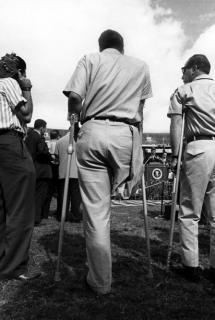Cubans Began to Revolt so They Were Put Into What to Keep Them From Continuing
The Bay of Pigs
On April 17, 1961, 1,400 Cuban exiles launched what became a botched invasion at the Bay of Pigs on the south coast of Cuba.
In 1959, Fidel Castro came to power in an armed revolt that overthrew Cuban dictator Fulgencio Batista. The US government distrusted Castro and was wary of his relationship with Nikita Khrushchev, the leader of the Soviet Union.
Before his inauguration, John F. Kennedy was briefed on a plan by the Central Intelligence Agency (CIA) developed during the Eisenhower administration to train Cuban exiles for an invasion of their homeland. The plan anticipated that the Cuban people and elements of the Cuban military would support the invasion. The ultimate goal was the overthrow of Castro and the establishment of a non-communist government friendly to the United States.
Training
President Eisenhower approved the program in March 1960. The CIA set up training camps in Guatemala, and by November the operation had trained a small army for an assault landing and guerilla warfare.
José Miró Cardona led the anti-Castro Cuban exiles in the United States. A former member of Castro's government, he was the head of the Cuban Revolutionary Council, an exile committee. Cardona was poised to take over the provisional presidency of Cuba if the invasion succeeded.
Despite efforts of the government to keep the invasion plans covert, it became common knowledge among Cuban exiles in Miami. Through Cuban intelligence, Castro learned of the guerilla training camps in Guatemala as early as October 1960, and the press reported widely on events as they unfolded.
Shortly after his inauguration, in February 1961, President Kennedy authorized the invasion plan. But he was determined to disguise U.S. support. The landing point at the Bay of Pigs was part of the deception. The site was a remote swampy area on the southern coast of Cuba, where a night landing might bring a force ashore against little resistance and help to hide any U.S. involvement. Unfortunately, the landing site also left the invading force more than 80 miles from refuge in Cuba's Escambray Mountains, if anything went wrong.
The Plan
The original invasion plan called for two air strikes against Cuban air bases. A 1,400-man invasion force would disembark under cover of darkness and launch a surprise attack. Paratroopers dropped in advance of the invasion would disrupt transportation and repel Cuban forces. Simultaneously, a smaller force would land on the east coast of Cuba to create confusion.
The main force would advance across the island to Matanzas and set up a defensive position. The United Revolutionary Front would send leaders from South Florida and establish a provisional government. The success of the plan depended on the Cuban population joining the invaders.
The Invasion
The first mishap occurred on April 15, 1961, when eight bombers left Nicaragua to bomb Cuban airfields.
The CIA had used obsolete World War II B-26 bombers, and painted them to look like Cuban air force planes. The bombers missed many of their targets and left most of Castro's air force intact. As news broke of the attack, photos of the repainted U.S. planes became public and revealed American support for the invasion. President Kennedy cancelled a second air strike.
On April 17, the Cuban-exile invasion force, known as Brigade 2506, landed at beaches along the Bay of Pigs and immediately came under heavy fire. Cuban planes strafed the invaders, sank two escort ships, and destroyed half of the exile's air support. Bad weather hampered the ground force, which had to work with soggy equipment and insufficient ammunition.
The Counterattack
Over the next 24 hours, Castro ordered roughly 20,000 troops to advance toward the beach, and the Cuban air force continued to control the skies. As the situation grew increasingly grim, President Kennedy authorized an "air-umbrella" at dawn on April 19—six unmarked American fighter planes took off to help defend the brigade's B-26 aircraft flying. But the planes arrived an hour late, most likely confused by the change in time zones between Nicaragua and Cuba. They were shot down by the Cubans, and the invasion was crushed later that day.
Some exiles escaped to the sea, while the rest were killed or rounded up and imprisoned by Castro's forces. Almost 1,200 members of Brigade 2506 surrendered, and more than 100 were killed.
The Aftermath
The brigade prisoners remained in captivity for 20 months, as the United States negotiated a deal with Fidel Castro. Attorney General Robert F. Kennedy made personal pleas for contributions from pharmaceutical companies and baby food manufacturers, and Castro eventually settled on $53 million worth of baby food and medicine in exchange for the prisoners.
On December 23, 1962, just two months after the end of the Cuban Missile Crisis, a plane containing the first group of freed prisoners landed in the United States. A week later, on Saturday, December 29, surviving brigade members gathered for a ceremony in Miami's Orange Bowl, where the brigade's flag was handed over to President Kennedy. "I can assure you," the president promised, "that this flag will be returned to this brigade in a free Havana."
The disaster at the Bay of Pigs had a lasting impact on the Kennedy administration. Determined to make up for the failed invasion, the administration initiated Operation Mongoose—a plan to sabotage and destabilize the Cuban government and economy, which included the possibility of assassinating Castro.
jacksontreadevent77.blogspot.com
Source: https://www.jfklibrary.org/learn/about-jfk/jfk-in-history/the-bay-of-pigs


0 Response to "Cubans Began to Revolt so They Were Put Into What to Keep Them From Continuing"
Post a Comment